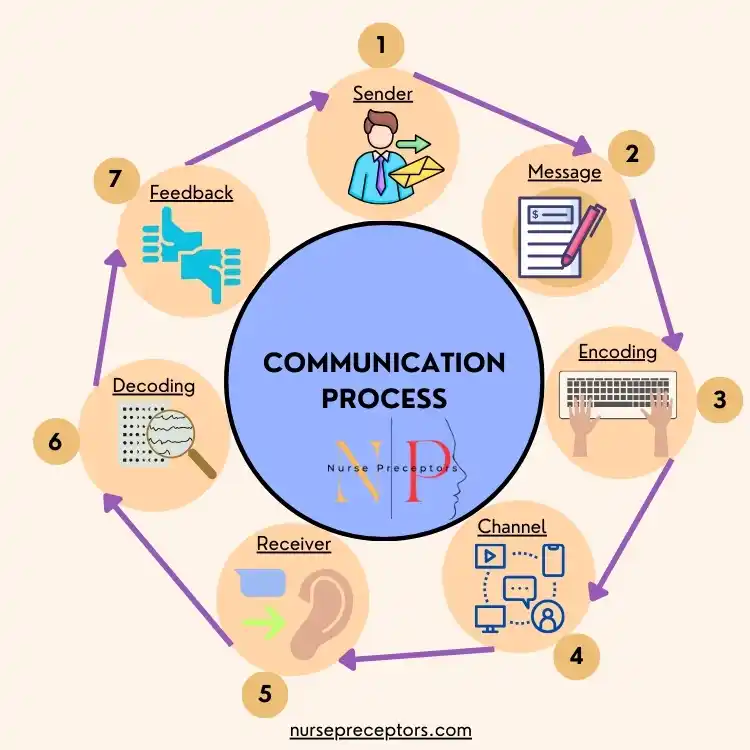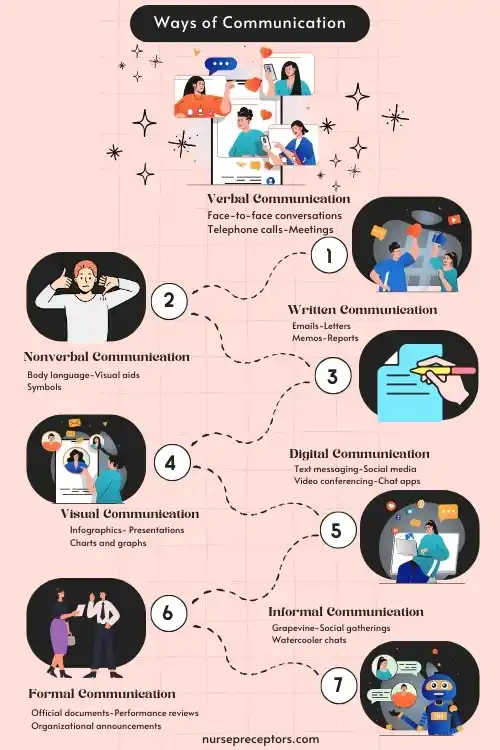What is Communication?
The communication process is exchanging information, ideas, thoughts, or feelings between individuals or groups through various mediums such as speech, writing, gestures, body language, or symbols.
It is a fundamental aspect of human interaction and plays a crucial role in conveying messages, building relationships, sharing knowledge, and fostering understanding.
Effective communication involves not only transmitting information but also ensuring that the message is accurately received and understood by the intended audience. You can learn a full guide about the Communication Process in the USA from Nurse Preceptors.
This requires clarity, empathy, active listening, and sometimes the ability to adapt communication style based on the context and the characteristics of the recipients.
Communication can occur through verbal means like conversations, presentations, or speeches, as well as nonverbal channels such as facial expressions, posture, or even silence.
It encompasses both interpersonal interactions between individuals and mass communication across broader audiences through various media like television, radio, print, or digital platforms.
In essence, communication is the cornerstone of human interaction, enabling people to connect, collaborate, and relate to one another in diverse personal, social, professional, and cultural contexts.
Elements of the Communication Process
Communication involves several key elements that work together to convey messages effectively. These elements include:

These elements interact dynamically throughout the communication process, influencing the effectiveness of message transmission and reception. Effective communication requires careful attention to each element and the ability to adapt to various contexts, audiences, and channels.
Ways of Communication
Communication can occur through various means or channels, depending on the context, purpose, and preferences of the communicators. Here are some common ways of communication:

1. Verbal Communication
- Face-to-face conversations: Direct interaction between individuals, allowing for real-time exchange of information, ideas, and emotions.
- Telephone calls: Verbal communication conducted over the phone, facilitating immediate communication over long distances.
- Meetings: Group discussions or presentations where participants engage in Effective Verbal Communication to share updates, brainstorm ideas, or make decisions.
2. Written Communication
- Emails: Electronic messages sent and received through email platforms, used for formal or informal communication in professional and personal contexts.
- Letters: Written correspondence sent via mail, often used for formal communication, such as business letters or personal correspondence.
- Memos: Short written messages distributed within organizations to convey announcements, updates, or instructions.
- Reports: Formal documents presenting information, findings, or analysis on a particular topic, intended for internal or external audiences.
3. Nonverbal Communication
- Body language: Gestures, facial expressions, posture, and eye contact are used to convey messages and emotions nonverbally during face-to-face interactions.
- Visual aids: Charts, graphs, diagrams, or presentations used to supplement verbal communication and enhance understanding.
- Symbols: Icons, logos, or signs that convey meaning or information without the need for verbal or written explanation.
4. Digital Communication
- Text messaging: Short written messages sent and received via mobile phones or messaging apps, allowing for quick and informal communication.
- Social media: Platforms such as Facebook, Twitter, Instagram, and LinkedIn are used to share information, engage in discussions, and connect with others online.
- Video conferencing: Real-time communication conducted over the internet, enabling individuals or groups to interact face-to-face from different locations.
- Chat apps: Instant messaging applications like WhatsApp, Slack, or Microsoft Teams are used for synchronous communication and collaboration.
5. Visual Communication
- Infographics: Visual representations of data, information, or concepts designed to convey complex ideas quickly and effectively.
- Presentations: Slideshows or multimedia presentations used to deliver information, persuade, or educate an audience visually.
- Charts and graphs: Visual tools such as bar charts, pie charts, or line graphs are used to illustrate data and trends for easier understanding.
6. Formal Communication Channels
- Official documents: Policies, procedures, manuals, or guidelines distributed within organizations to convey formal information or instructions.
- Organizational announcements: Emails, memos, or newsletters issued by management to communicate important updates, events, or decisions to employees.
- Performance reviews: Formal evaluations conducted by supervisors to provide feedback and assess employees’ performance.
7. Informal Communication Channels
- Grapevine: Informal communication networks within organizations where rumors, gossip, or unofficial information are shared among employees.
- Social gatherings: Casual interactions and conversations among coworkers during breaks, lunches, or after-work events.
- Watercooler chats: Spontaneous conversations that occur around common areas like watercoolers or coffee machines, fostering informal communication and camaraderie among coworkers.
These are just some of the many ways people communicate in their personal and professional lives, each with its advantages, limitations, and suitability for different situations.
Effective communicators understand when and how to use various communication channels to convey their messages clearly and achieve their communication goals.
Conclusion
In conclusion, the communication process is a complex yet fundamental aspect of human interaction. This process, which comprises several key elements including the sender, receiver, message, channel, and feedback, plays an integral role in facilitating understanding and exchange of information among individuals.
The ways in which this process is executed could vary, ranging from verbal communication such as face-to-face conversations and phone calls, to non-verbal modes including emails and body language.
Effective communication is not just about transmitting messages but also ensuring that they are correctly interpreted and understood. This highlights the importance of feedback in the communication process.
Feedback serves as a mechanism for the sender to confirm if the message has been accurately received and understood by the receiver.
References:
- Berman, A., Snyder, S., & Frandsen, G. (2016). Kozier & Erb’s Fundamentals of Nursing: Concepts, Practice, and Process (10th ed.). Pearson.
- Delaune, S. C., & Ladner, P. K. (2002). Fundamentals of nursing: standards & practice. Delmar Thomson Learning.
- Weiss, S. A., & Tappen, R. M. (2015). Essentials of nursing leadership and management (6th ed.). F.A. Davis Company.
- Patricia Ann Potter, Anne Griffin Perry, Stockert, P. A., & Hall, A. (2019). Essentials for nursing practice. Elsevier.
- Elements of Communication Process. (2022, August 28). GeeksforGeeks. https://www.geeksforgeeks.org/elements-of-communication-process/
- S, S. (2017, January 21). What is Communication? definition, elements, forms, and modes. Business Jargons. https://businessjargons.com/communication.html#google_vignette
- Dham, M. (2023, August 24). Elements of Communication Process. PrepBytes Blog. https://www.prepbytes.com/blog/basics-of-communication/elements-of-communication-process/
- Ashman, M. (2018). 1.2 Elements in communication. Pressbooks.bccampus.ca. https://pressbooks.bccampus.ca/professionalcomms/chapter/1-2-elements-in-communication/
- Keiling, H. (2019, March 8). 4 Types of Communication (With Examples) | Indeed.com. Indeed.com. https://www.indeed.com/career-advice/career-development/types-of-communication
- Lumen. (2012). Different Types of Communication | Principles of Management. Lumenlearning.com. https://courses.lumenlearning.com/atd-tc3-management/chapter/different-types-of-communication/